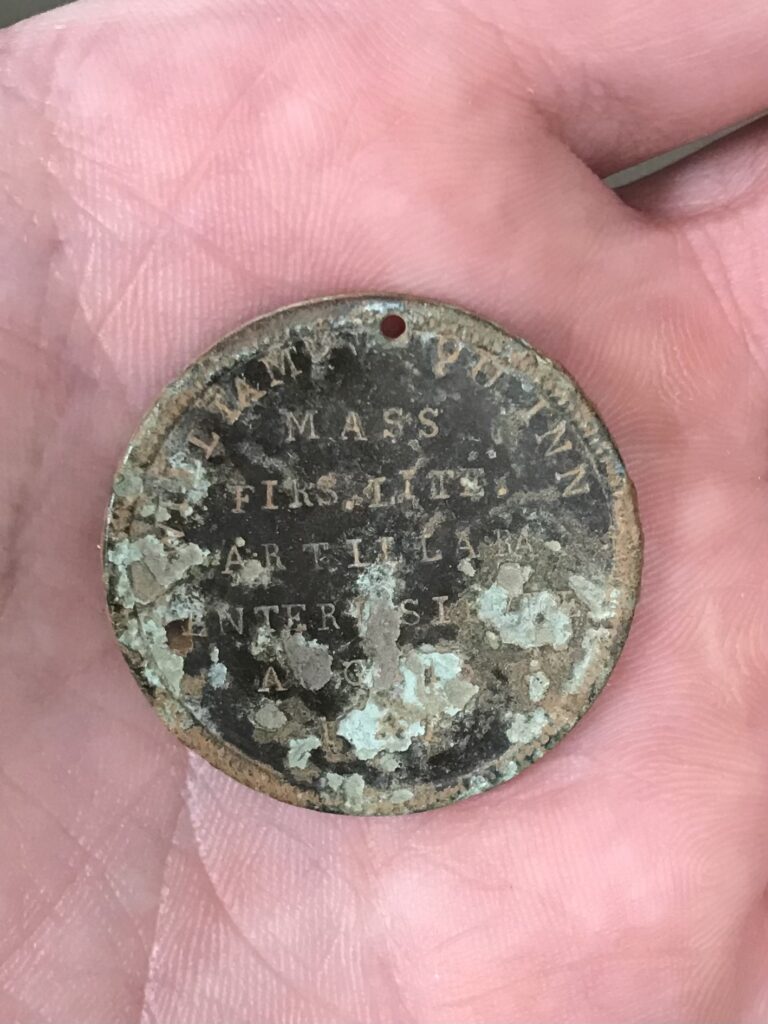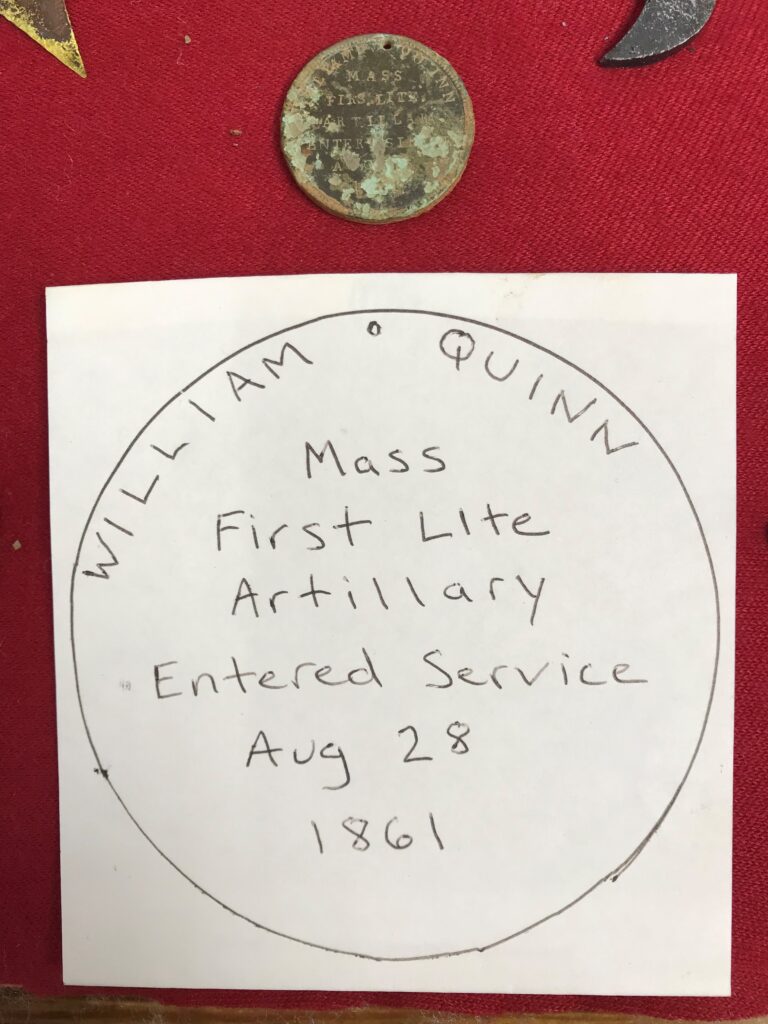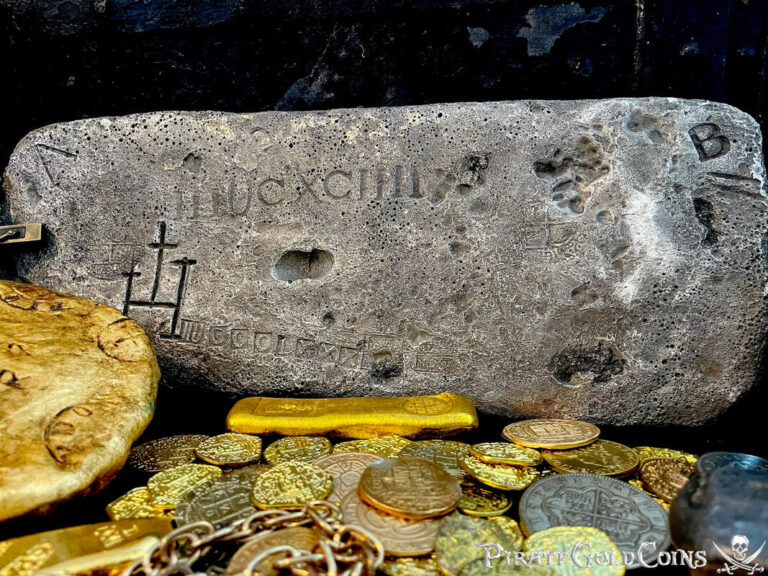As relic hunters, we all know there are treasures just waiting to be found under our feet. What we sometimes don’t realize, is that there are actual treasures within the relics we find. For example, the Gone Diggin crew went on an organized relic hunting event in Culpepper County to have the opportunity to dig at a massive Civil War winter camp at Brandy Station. We found that as a group, we can be more efficient on finding small “hot pockets” of relics to be able to share with the whole group. We also have found, that when we are in these winter camps with huts and pits, its much more enjoyable to dig it as a group and share what we find. While we were on a hillside known to have winter huts, we all slowed down to listen to low faint tones on our Minelab GPX 4500 machines. Between all the iron nail signals, I was able to find a nice looong low tone that came through my headphones. I immediately called over the Gone Diggin crew to help investigate this signal. After we dug down about 12” into the red dirt of Culpepper, we found a barrel band and tons of ash, which are tall tale signs of a pit or a hut. As we worked the dirt off the floor of the hut, Jamie rolled out a green disc. First thought was YES, a coin! But after we cleaned some dirt off, we were astonished to see a Civil War soldiers ID disc. This as many will know, is a find of a lifetime and we celebrated like a bunch of kids in a candy store! Ive never found a relic that I could specifically tie to a soldier but I knew that many others have found information on the soldiers on ID discs. The search was on!
I was able to find his papers from where he mustered into service and from when he finished his duties. One really neat find was some papers where William Quinn “Lost one pair of cross cannons April 30, 1862; also one number.” Matt found three cross cannon insignias on that same hill side, could one have been a pair lost by William? It was so much fun being able to look into the stories of William Quinn’s Battery. I found that the actual treasure was the research into the past, to try and revisit the steps of this single soldier and the life that he lived during the time known as the “American Civil War”.
I put together some information from my research and I hope it will give you as much pleasure reading it, as it gave me researching it.


William Quinn
William Quinn, born in 1842 in Providence, Rhode Island was just a boy at the age of 19 when he decided to enlist into the military to serve his country. August 28th 1861, he and 151 other brave men, entered service for their 3 year term with the First Massachusetts Light Battery, Battery A, under the command of Captain Josiah Porter of Cambridge. Private William Quinn was assigned to the sixth detachment of the third section (Centre) of the battery. The First Mass Light Battery consisted of 4 brass smooth bore 6 pounders and two 12 pound Howitzers. William Quinn’s Centre section would have been assigned the 6 pound gun, but for only a short duration of the war did they use this gun. Early on in their journey they exchanged all (4) of the 6 pound smooth bore cannons for (4) ten pound parrots.
This Battery, attached to the Sixth Army Corps, fought in many battles such as Mechanicsville, Seven days battle, Gaines Mill, Charles City Cross Roads, Malvern Hill, Antietam, Fredericksburg, Salem Heights, Gettysburg, Wilderness, Spotsylvania Court house, Cold Harbor, and the siege of Petersburg, to only name a few. Astonishingly enough, the 1st Mass Battery only lost 21 enlisted men during the American Civil War. One recollection of an event, stated in “The Story of the First Massachusetts Light Battery, attached to the Sixth army Corps” by Andrew Bennett (Andrew Bennett was in the same Centre section of the battery as William Quinn), was during the Battle of Spotsylvania Court House, when General John Sedgwick was directing the First Massachusetts Battery emplacements. Sedgwick saw members of the of the battery ducking from confederate sharpshooter fire from over 1000 yards away. He quickly strode around in the open and was quoted saying, “What? Men dodging this way for single bullets? What will you do when they open fire along the whole line?” Ashamed, the men in the battery continued to flinch, as the Minnie balls whizzed by. Again, he strode in front of the battery and said, “Pooh! They can’t hit an elephant at this distance!’’ These were the last words Sedgwick ever uttered on this earth as a Confederate sharpshooter shot him under his left eye with a Whitworth. His chief of staff, Martin T. McMahon, said that the sharpshooters’ bullets were flying all around, making whistling noises, and “The same shrill whistle closing with a dull, heavy stroke interrupted me, and I remember distinctly that I commenced to say ‘General, they are firing explosive bullets.’ when his face turned slowly to me, and blood spurting from his left cheek under the eye in a steady stream, brought to me the first knowledge of our great disaster. He fell in my direction and I was so close to him that my effort to support him failed, and I went to the ground with him.” General John Sedgwick fell between the guns of the right section of the First Massachusetts Light Battery.

December of 1863 to May of 1864 the First Massachusetts Light Battery was to make winter quarters at Brandy Station on a hillside we now call “The Bean Field”. The Battery was to dig in on the red clay of Culpepper County Va to make it through a long and cold winter. Here he would have indulged in the camp life of a seasoned battle veteran, drinking whiskey and telling stories by camp fires of the hardships of battles. Sutlers were very common in these camps and by this time in the war, death was on every soldier’s mind. They would go to a sutler and purchase ID discs so they could be identified to have their bodies returned to their families. At some point in William Quinn’s journey, he found it necessary to purchase one for himself. In Brandy Station, on that hillside known as “The Bean Field”, Gone Diggin Crew found the 10X10 hut of William Quinn. A very surreal moment to know the name of the man who’s hut you are standing in 155 years later. In this hut were several personal items that he would have owned. Lice Comb, breach lock to a Spenser rifle, ID disc, artillery button, Whiskey bottles, and ration cans were found on the extremely clean floor of this hut. I’ve read that these men took extreme pride in the construction of their huts in this camp. The construction was some of the best in the entire camp. They would join the 6th Vermont in their chapel, which was large enough to accommodate an entire regiment, every week and sing songs. They would even have athletic competitions such as leaping, sparring, and racing in the Massachusetts camp. I can only imagine the beauty of this camp from the shear size of the army camped there, I bet it was quite the spectacle.

William Quinn survived the war and mustered out of service August 29th, 1864 in Charlestown Va. He would go on to live in Rockingham, New Hampshire and marry Harriet Mellissa Sanborn. In 1882, at the age of 40, he passed away in Hennepin, Minnesota of reasons unknown to my knowledge at this point in time. I still am vigorously searching for all the information I can find on this gentleman and the accomplishments of his lifetime. I still have high hopes that one day I will come across a picture of William Quinn and can actually put a face to all of this incredible information found thus far.


